The Evaluation of Single-Family Detached Housing Units in terms of Integrated Photovoltaic Shading Devices: The Case of Northern Cyprus
Abstract
1. Introduction
2. BIPV and PVSD
3. The Context of the Study
4. Materials and Methodology
Building and PVSD Case Study
5. Result and Findings
5.1. Sun Shading Chart
5.2. Psychrometric Chart Results
- Sun shading of windows: as presented in Figure 15, shading on the chart takes up to 15.2% that is about 1328 h of the year. Through the use of shading devices, 1328 uncomfortable hours are converted to comfortable hours.
- Two stage evaporative cooling: in the two-stage evaporative cooling strategy, first a thermal converter is used to reduce the temperature, then the comfort condition is applied by direct evaporative cooling. This process makes up 1.7% (146 h annually).
- Natural ventilation cooling: natural ventilation is required for cooling for about 102 h of the year (1.2%).
- Internal heat gain: 36.4% of thermal comfort can be achieved by internal heat gained from within the building from artificial lighting, electrical equipment, and indoor activities by occupants. This is about 3188 h of the year.
- Passive solar direct gain high mass: the is the number of hours in the year where thermal comfort is achieved through passive solar gain. This includes a total of about 1713 h (19.6%).
- Wind protection of outdoor spaces: in this segment of the chart, building wind protection by outdoor elements such as plants is required to achieve the comfort conditions. This includes 0.5% making up a total of 43 h of the year.
- Dehumidification only: dehumidification is required to achieve thermal comfort in the building for a total of about 984 h of the year, making up 11.2%.
- Cooling, add humidification if needed: to achieve comfort, this strategy requires both cooling and humidification at the same time. This includes a total of 1806 h of the year (20.6%).
- Heating, add humidification if needed: to achieve comfort, this strategy requires both humidification and increasing air temperature by mechanical heating. This includes a total of 772 h of the year (8.8%).
5.3. Solar Shading Performance Result
- Windows directly facing the south would need more shading from the sun, and the horizontal overhangs work better for southern façades. The east and west would require both vertical fins and horizontal overhanging used in the passive design strategies, while on the northern façade, shading is completely avoided as exposure to the sun is needed for the interior space of the building.
5.4. Cooling Design Strategy
5.5. Total energy generated by the PVSDs and Cell Type
- E = energy (kWh),
- A = total solar panel area (20.4 m²),
- r = solar panel yield (estimated to be 12%),
- H = annual average irradiation on tilted panels (1800), and PR = performance ratio, coefficient for losses (0.75). The energy becomes more than 3300 kWh/annum.
6. Conclusions
Author Contributions
Funding
Acknowledgments
Conflicts of Interest
References
- Statistical Review of World Energy (June 2016). Available online: https://www.bp.com/en/global/corporate/energy-economics/statistical-review-of-world-energy.html (accessed on 10 November 2018).
- KIB-TEK (2018). Available online: https://www.kibtek.com/ (accessed on 5 December 2018).
- Elinwa, U.K.; Radmehr, M.; Ogbeba, J.E. Alternative energy solutions using BIPV in apartment buildings of developing countries: A case study of North Cyprus. Sustainability 2017, 9, 1414. [Google Scholar] [CrossRef]
- Ozbalta, T.G. Fotovoltaik teknolojisi ile bina kabuğunun degisen işlevleri ve yüzeyleri; Dizayn Konstrüksiyon Issue 281; Anadolu Üniversitesi Mimarlık Fakultesi: Eskişehir, Turkey, 2009; pp. 75–81. [Google Scholar]
- Jelle, B.P.; Breivik, C.; Røkenes, H.D. Building integrated photovoltaic products: A state-of-the-art review and future research opportunities. Sol. Energy Mater. Sol. Cells 2012, 100, 69–96. [Google Scholar] [CrossRef]
- Ali, M.M.; Armstrong, P.J. Overview of sustainable design factors in high-rise buildings. In Proc. of the CTBUH 8th World Congress; CTBUH: Chicago, IL, USA, 2008; pp. 3–5. [Google Scholar]
- Altin, M. Binaların Enerji Ihtiyacinin PV Bilesenli Cepheler ile Azaltilmasi 3. Ulusal Cati ve Cephe Kaplamalarinda Cagdas Malzeme ve Teknolojileri Sempozyumu. 17–18 Ekim 2006, ITU Mimarlık Fakultesi, Taskisla. Retrieved from World Wide Web on 1 June 2011. Available online: http://www.catider.org.tr/pdf/sempozyum/Bil7.pdf (accessed on 10 October 2018).
- Das, S.K.; Verma, D.; Nema, S.; Nema, R.K. Shading mitigation techniques: State-of-the-art in photovoltaic applications. Renew. Sustain. Energy Rev. 2017, 78, 369–390. [Google Scholar] [CrossRef]
- Garde, F.; Bastide, A.; Wurtz, E.; Achard, G.; Dobre, O.; Thellier, F.; Ottenwelter, E.; Ferjani, N.; Bornarel, A. ENERPOS: A National French Research Program for Developing New Methods for the Design of Zero Energy Buildings, CESB 07; Central Europe towards Sustainable Buildings: Prague, Czech Republic, 2007. [Google Scholar]
- Li, X.; Strezov, V. Energy and Greenhouse Gas Emission Assessment of Conventional and Solar Assisted Air Conditioning Systems. Sustainability 2015, 7, 14710–14728. [Google Scholar] [CrossRef]
- Zhai, X.Q.; Wang, R.Z.; Dai, Y.J.; Wu, J.Y.; Xu, Y.X.; Ma, Q. Solar integrated energy system for a green building. Energy Build. 2007, 39, 985–993. [Google Scholar] [CrossRef]
- Imal, M.; Yılmaz, K.; Pınarbaşı, A. Energy Efficiency Evaluation and Economic Feasibility Analysis of a Geothermal Heating and Cooling System with a Vapor-Compression Chiller System. Sustainability 2015, 7, 12926–12946. [Google Scholar] [CrossRef]
- Nocera, F.; Faro, A.L.; Costanzo, V.; Raciti, C. Daylight Performance of Classrooms in a Mediterranean School Heritage Building. Sustainability 2018, 10, 3705. [Google Scholar] [CrossRef]
- Costanzo, V.; Evola, G.; Marletta, L.; Nascone, F.P. Application of Climate Based Daylight Modelling to the Refurbishment of a School Building in Sicily. Sustainability 2018, 10, 2653. [Google Scholar] [CrossRef]
- Dunn, J.R.; Hayes, M.V. Social inequality, population health, and housing: A study of two Vancouver neighborhoods. Soc. Sci. Med. 2000, 51, 563–587. [Google Scholar] [CrossRef]
- Sadalla, E.K.; Sheets, V.L. Symbolism in building materials: Self-presentational and cognitive components. Environ. Behav. 1993, 25, 155–180. [Google Scholar] [CrossRef]
- Halpern, D. Mental Health and the Built Environment: More Than Bricks and Mortar? Routledge: Abingdon, UK, 2014. [Google Scholar]
- Liu, Z.; Osmani, M.; Demian, P.; Baldwin, A.N. The Potential Use of BIM to Aid Construction Waste Minimalization; Centre Scientifique et Technique du Bâtiment: Marne-la-Vallée, France, 2011. [Google Scholar]
- Cardona, A.J.A.; Chica, C.A.P.; Barragán, D.H.O. Building-Integrated Photovoltaic Systems (BIPVS): Performance and Modeling Under Outdoor Conditions; Springer: Berlin, Germany, 2018. [Google Scholar]
- Assoa, Y.B.; Mongibello, L.; Carr, A.; Kubicek, B.; Machado, M.; Merten, J.; Misara, S.; Roca, F.; Sprenger, W.; Wagner, M.; et al. Thermal analysis of a BIPV system by various modelling approaches. Sol. Energy 2017, 155, 1289–1299. [Google Scholar] [CrossRef]
- Shukla, A.K.; Sudhakar, K.; Baredar, P.; Mamat, R. Solar PV and BIPV system: Barrier, challenges and policy recommendation in India. Renew. Sustain. Energy Rev. 2017, 82, 3314–3322. [Google Scholar] [CrossRef]
- Heinstein, P.; Ballif, C.; Perret-Aebi, L. Building integrated photovoltaics (BIPV): Review, potentials, barriers and myths. Green 2013, 3, 125–156. [Google Scholar] [CrossRef]
- Dehra, H. An investigation on energy performance assessment of a photovoltaic solar wall under buoyancy-induced and fan-assisted ventilation system. Appl. Energy 2017, 191, 55–74. [Google Scholar] [CrossRef]
- Luo, Y.; Zhang, L.; Liu, Z.; Wu, J.; Zhang, Y.; Wu, Z.; He, X. Performance analysis of a self-adaptive building integrated photovoltaic thermoelectric wall system in hot summer and cold winter zone of China. Energy 2017, 140, 584–600. [Google Scholar] [CrossRef]
- Martin, J., II. BIPV: Building-Integrated Photovoltaics, the Future of PV. 2011. Available online: http://www.solarchoice.net.au/blog/bipv-building-integrated-photovoltaics-the-future-of-pv/ (accessed on 12 October 2016).
- Hagemann, I. Shading systems with PV A new market for prefabricated building elements? In Environmentally Friendly Cities: Proceedings of Plea 1998, Passive and Low Energy Architecture, 1998, Lisbon, Portugal, June 1998; James & James (Science Publishers) Ltd: London, UK, 2014; Volume 373. [Google Scholar]
- Tablada, A.; Kosorić, V.; Huang, H.; Chaplin, I.; Lau, S.; Yuan, C.; Lau, S. Design Optimization of Productive Façades: Integrating Photovoltaic and Farming Systems at the Tropical Technologies Laboratory. Sustainability 2018, 10, 3762. [Google Scholar] [CrossRef]
- Kahoorzadeh, A. Improvement of Thermal Comfort in Residential Buildings by Passive Solar Strategies Using Direct Gain Techniques. Ph.D. Thesis, Eastern Mediterranean University (EMU)-Doğu Akdeniz Üniversitesi (DAÜ), Famagusta, Norther Cyprus, 2013. [Google Scholar]
- Pester, S.; Crick, F. Performance of Photovoltaic Systems on Non-Domestic Buildings; IHS BRE Press: St Albans, UK, 2013. [Google Scholar]
- Taveres-Cachat, E.; Bøe, K.; Lobaccaro, G.; Goia, F.; Grynning, S. Balancing competing parameters in search of optimal configurations for a fix louvre blade system with integrated PV. Energy Procedia 2017, 122, 607–612. [Google Scholar] [CrossRef]
- Zhang, W.; Lu, L.; Peng, J. Evaluation of potential benefits of solar photovoltaic shadings in Hong Kong. Energy 2017, 137, 1152–1158. [Google Scholar] [CrossRef]
- Yoo, S.-H.; Lee, E. Efficiency characteristic of building integrated photovoltaics as a shading device. Build. Environ. 2002, 37, 615–623. [Google Scholar] [CrossRef]
- Bahr, W. A comprehensive assessment methodology of the building integrated photovoltaic blind system. Energy Build. 2014, 82, 703–708. [Google Scholar] [CrossRef]
- Nagy, Z.; Svetozarevic, B.; Jayathissa, P.; Begle, M.; Hofer, J.; Lydon, G.; Willmann, A.; Schlueter, A. The adaptive solar facade: From concept to prototypes. Front. Archit. Res. 2016, 5, 143–156. [Google Scholar] [CrossRef]
- Pérez-Alonso, J.; Pérez-García, M.; Pasamontes-Romera, M.; Callejón-Ferre, A.J. Performance analysis and neural modelling of a greenhouse integrated photovoltaic system. Renew. Sustain. Energy Rev. 2012, 16, 4675–4685. [Google Scholar] [CrossRef]
- Aksugur, E. Potential of passive cooling strategies in Cyprus. In Housing Research Conference, European Network in Housing Research; ENHR: Helsingor, Denmark, 1996; Volume 174. [Google Scholar]
- Oktay, D. Design with the climate in housing environments: An analysis in Northern Cyprus. Build. Environ. 2002, 37, 1003–1012. [Google Scholar] [CrossRef]
- iSHAN JAIN (2017) How to Design A Shading Device? Available online: http://talkarchitecture.in/how-to-design-a-shading-device/ (accessed on 7 August 2018).
- Kuhn, T.E.; Bühler, C.; Platzer, W.J. Evaluation of overheating protection with sun-shading systems. Sol. Energy 2001, 69, 59–74. [Google Scholar] [CrossRef]
- Valladares-Rendón, L.G.; Schmid, G.; Lo, S. Review on energy savings by solar control techniques and optimal building orientation for the strategic placement of façade shading systems. Energy Build. 2017, 140, 458–479. [Google Scholar] [CrossRef]
- Kirimtat, A.; Koyunbaba, B.K.; Chatzikonstantinou, I.; Sariyildiz, S. Review of simulation modeling for shading devices in buildings. Renew. Sustain. Energy Rev. 2016, 53, 23–49. [Google Scholar] [CrossRef]
- Zhang, X.; Lau, S.; Lau, S.S.Y.; Zhao, Y. Photovoltaic integrated shading devices (PVSDs): A review. Sol. Energy 2018, 170, 947–968. [Google Scholar] [CrossRef]
- James, T.; Goodrich, A.; Woodhouse, M.; Margolis, R.; Ong, S. Building-Integrated Photovoltaics (BIPV) in the residential sector: An analysis of installed rooftop system prices. Contract 2011, 303, 275–3000. [Google Scholar]
- Weller, B. Detail Practice: Photovoltaics; Birkhäuser: Basel, Switzerland, 2010. [Google Scholar]
- Leskovar, V.Ž.; Premrov, M. An approach in architectural design of energy-efficient timber buildings with a focus on the optimal glazing size in the south-oriented façade. Energy Build. 2011, 43, 3410–3418. [Google Scholar] [CrossRef]
- Boxwell, M. The Solar Electricity Handbook-2017 Edition: A Simple, Practical Guide to Solar Energy–Designing and Installing Solar Photovoltaic Systems; Greenstream Publishing: Coventry, UK, 2017. [Google Scholar]
- Ozay, N. A comparative study of climatically responsive house design at various periods of Northern Cyprus architecture. Build. Environ. 2005, 40, 841–852. [Google Scholar] [CrossRef]
- TRNC (2006) TRNC General Population and Housing Unit Census. Available online: http://nufussayimi.devplan.org/Census%202006.pdf (accessed on 5 December 2018).
- Özdeniz, M.B.; Hançer, P. Suitable roof constructions for warm climates—Gazimağusa case. Energy Build. 2005, 37, 643–649. [Google Scholar] [CrossRef]
- Hancer, P. Thermal Insulations of Roofs for Warm Climates. Ph.D. Thesis, Eastern Mediterranean University, Famagusta, Northern Cyprus, 2005. [Google Scholar]
- ontheworldmap.com. Available online: http://ontheworldmap.com/cyprus/city/famagusta/famagusta-location-on-the-cyprus-map.jpg (accessed on 15 January 2019).
- Lapithis, P.A. Passive solar architecture in Cyprus; Lapithis Architectural Firm: Lefkosa, Cyprus, 2005. [Google Scholar]
- Climatemps.com. Available online: http://www.famagusta.climatemps.com/ (accessed on 14 August 2018).
- Pourvahidi, P. Bioclimatic Analysis of Vernacular Iranian Architecture. Ph.D. Thesis, Eastern Mediterranean University (EMU), Famagusta, Northern Cyprus, 2010. [Google Scholar]
- Atalar, E. Evaluation of Solar Insolation in Northern Cyprus. Ph.D. Thesis, Eastern Mediterranean University, Famagusta, Northern Cyprus, 2001. [Google Scholar]
- Theodoros, Z.; Hadjikyriakou, C. State of the Art of Power Generation in Cyprus. In Social Costs and Benefits of Renewable Electricity Generation in Cyprus; Springer: Cham, Switzerland, 2016; pp. 7–16. [Google Scholar]
- Solar resource map © 2018 Solargi. Available online: https://solargis.com/maps-and-gis-data/download/cyprus (accessed on 21 January 2019).
- Energyplus (2018), EnergyPlus. Available online: https://energyplus.net/ (accessed on 4 December 2018).
- Reta, T. Leveraging a Building Information Model to Carry Out Building Energy Performance Analysis. Bachelor’s Thesis, Helsinki Metropolia University of Applied Sciences, Helsinki, Finland, 2017. [Google Scholar]
- Murray, M.; Liggett, R.; Benson, A.; Bhattacharya, Y. Climate Consultant 4.0 develops design guidelines for each unique climate. In American Solar Energy Society Meeting; ASES: Boulder, CO, USA, 2009. [Google Scholar]
- Mesda, Y. Heat Transfer Coefficient Analysis of the Chamber of Cyprus Turkish Architects Office Building on the Zahra Street in the Walled City of Nicosia in Cyprus. Archit. Res. 2012, 2, 47–54. [Google Scholar] [CrossRef]
- Optimum Tilt of Solar Panels. Available online: https://www.solarpaneltilt.com/ (accessed on 28 December 2018).


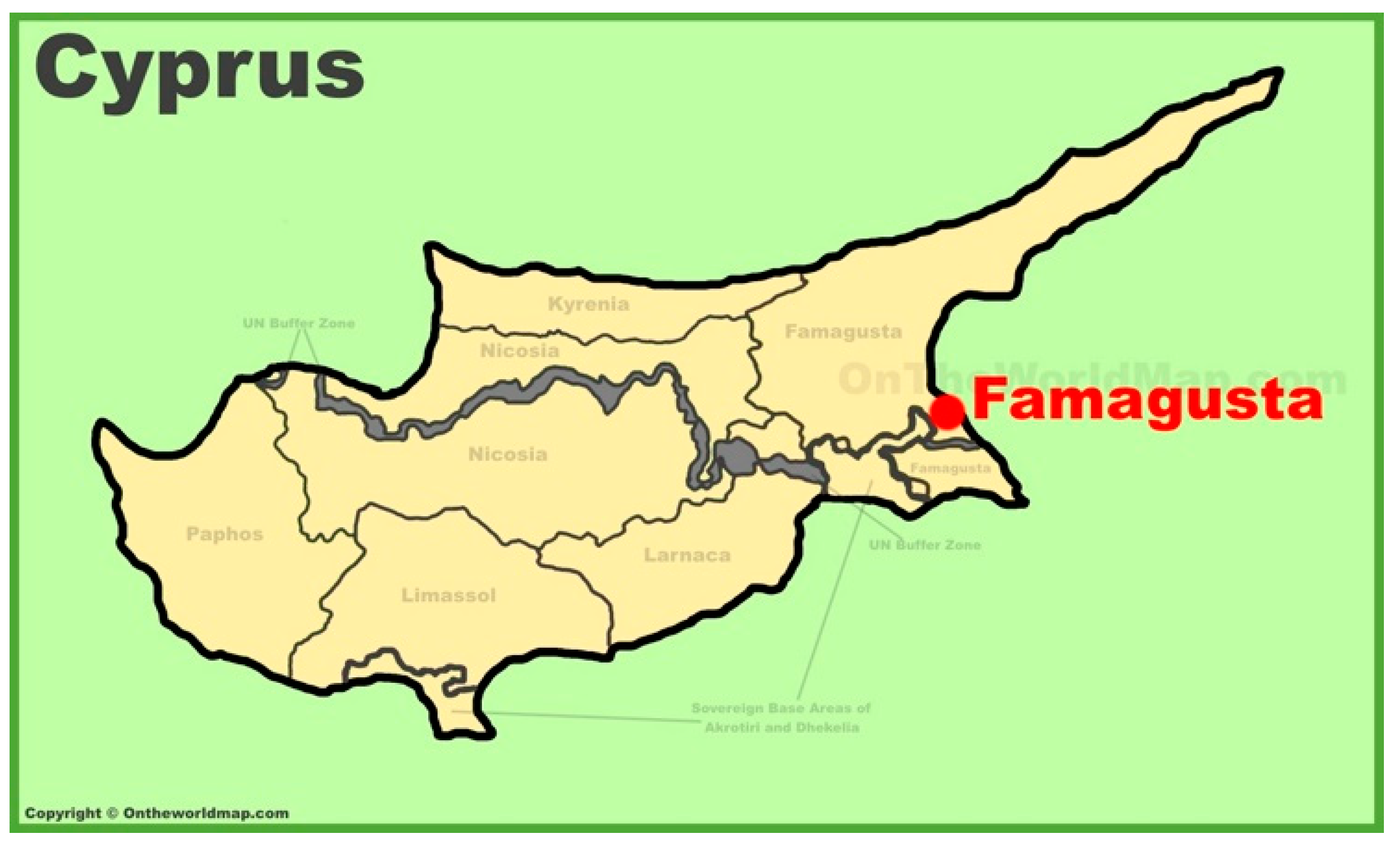
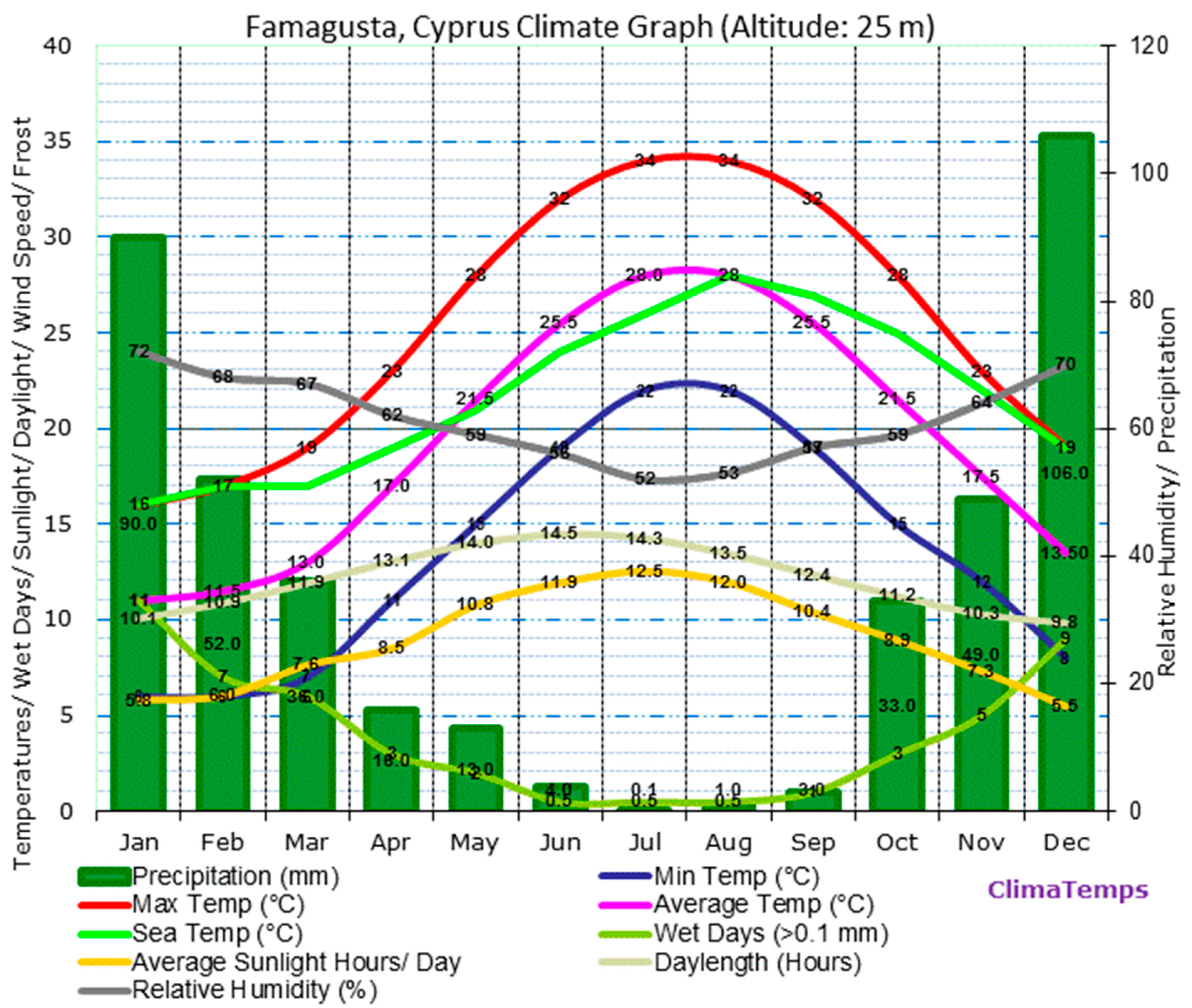
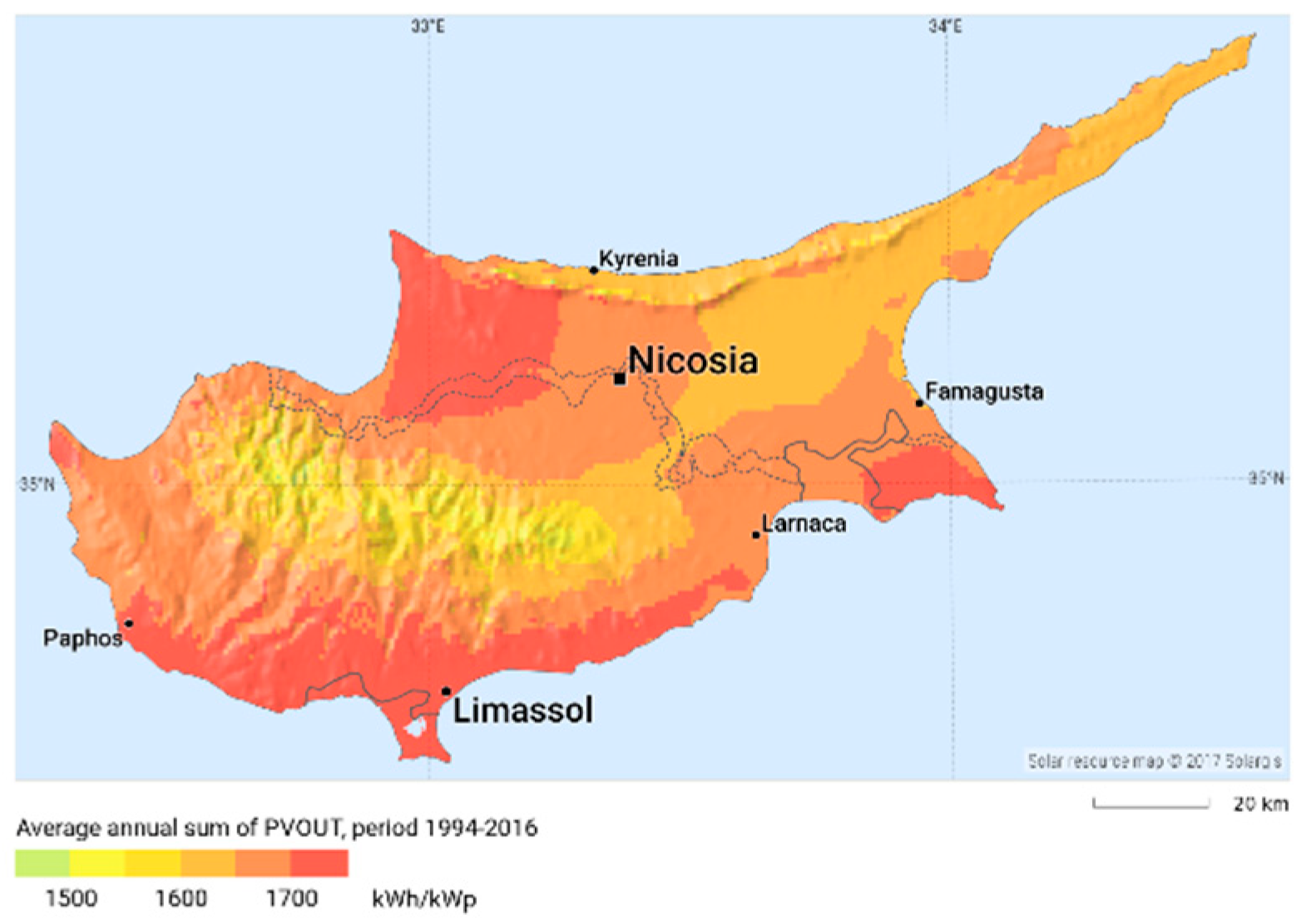

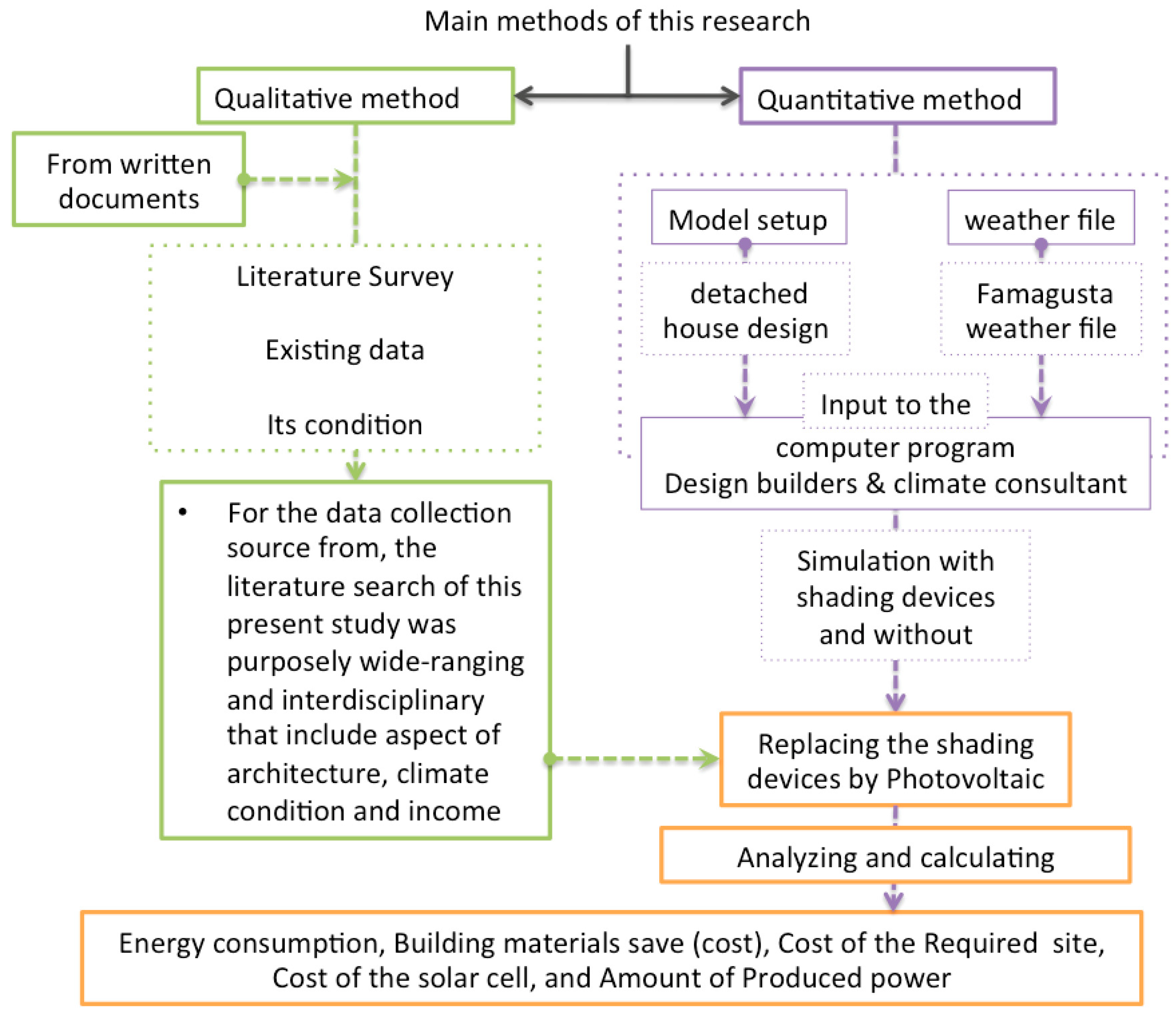
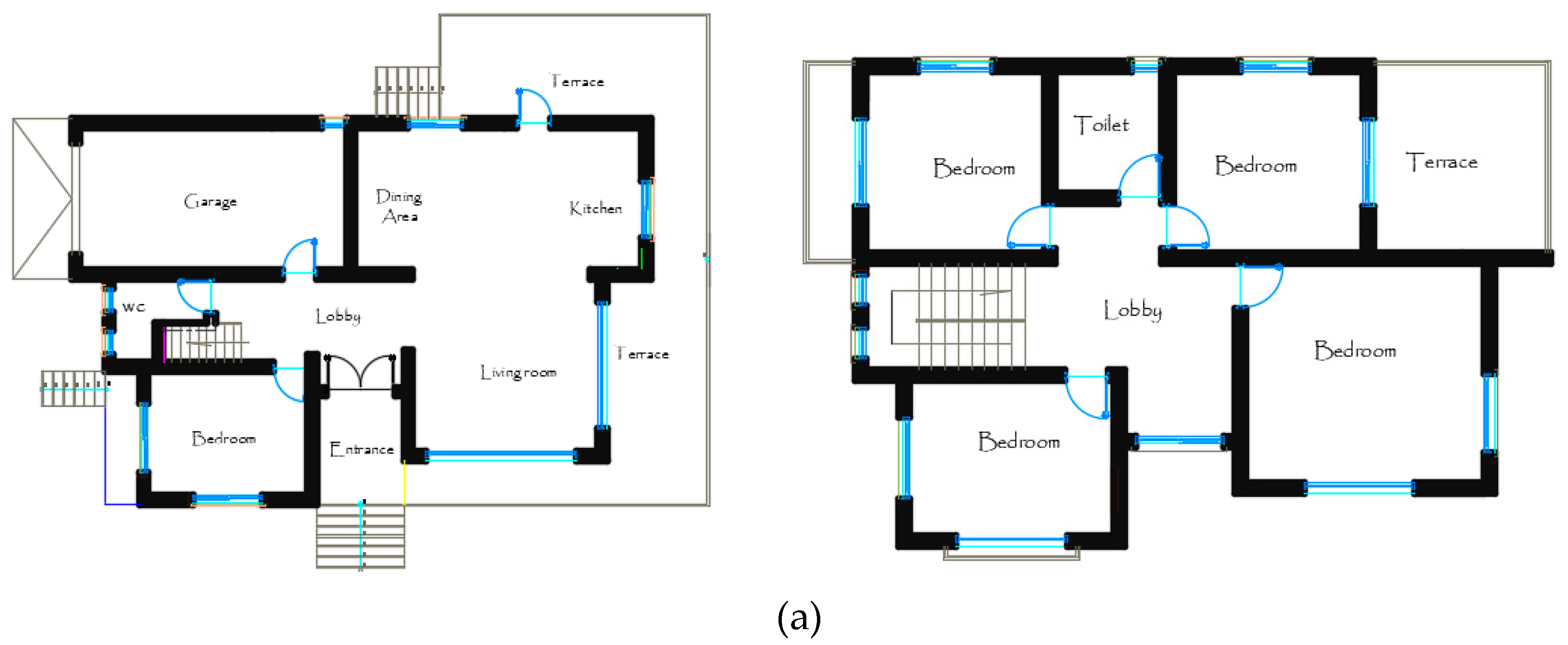
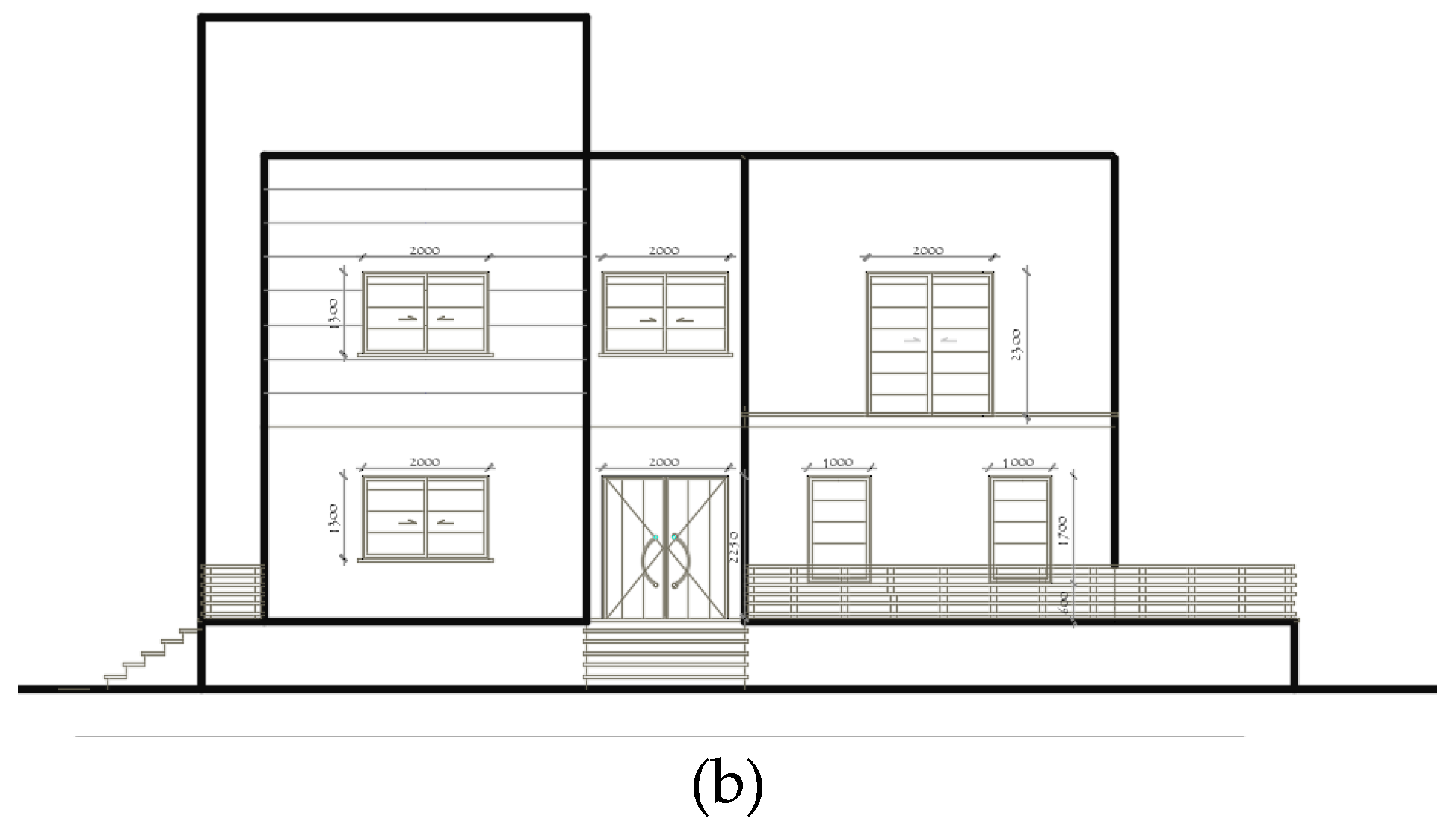
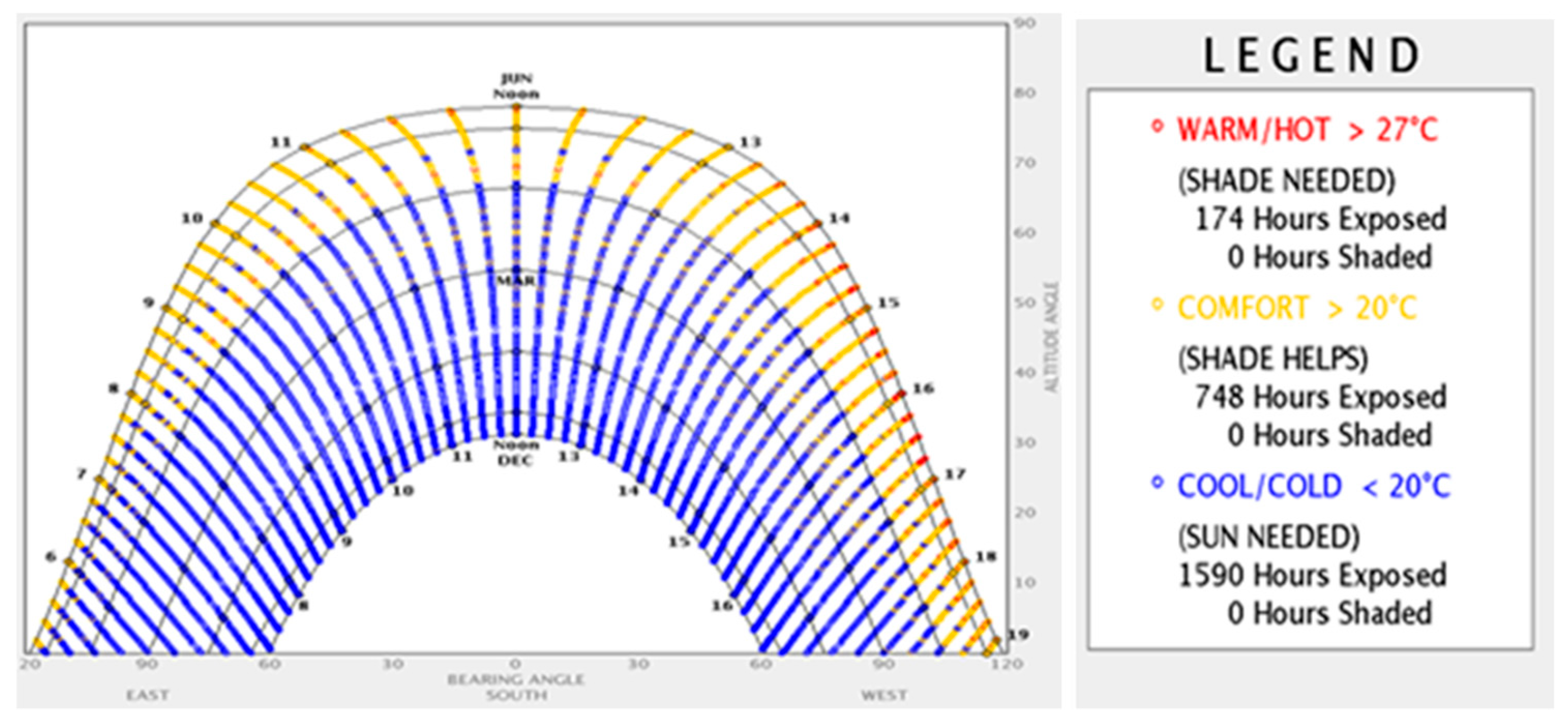
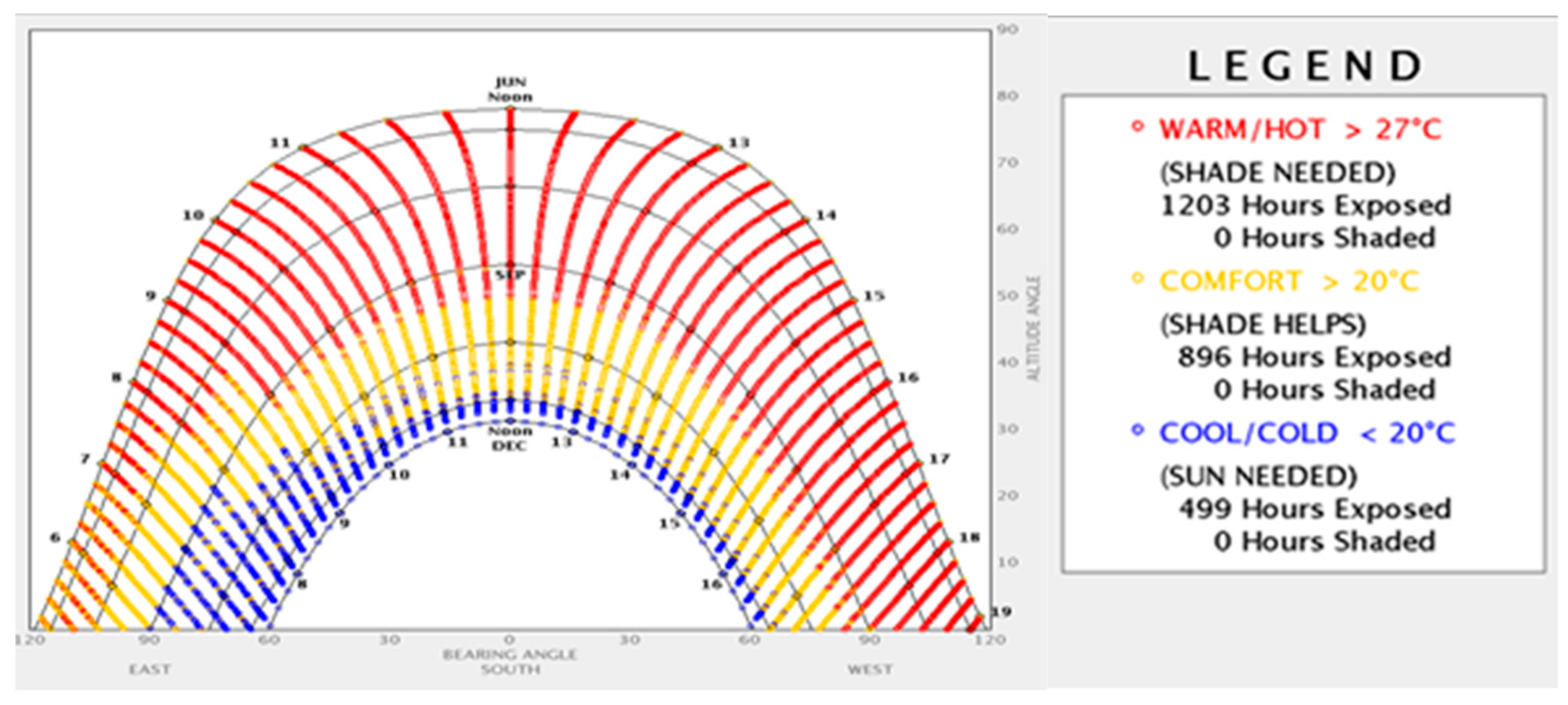
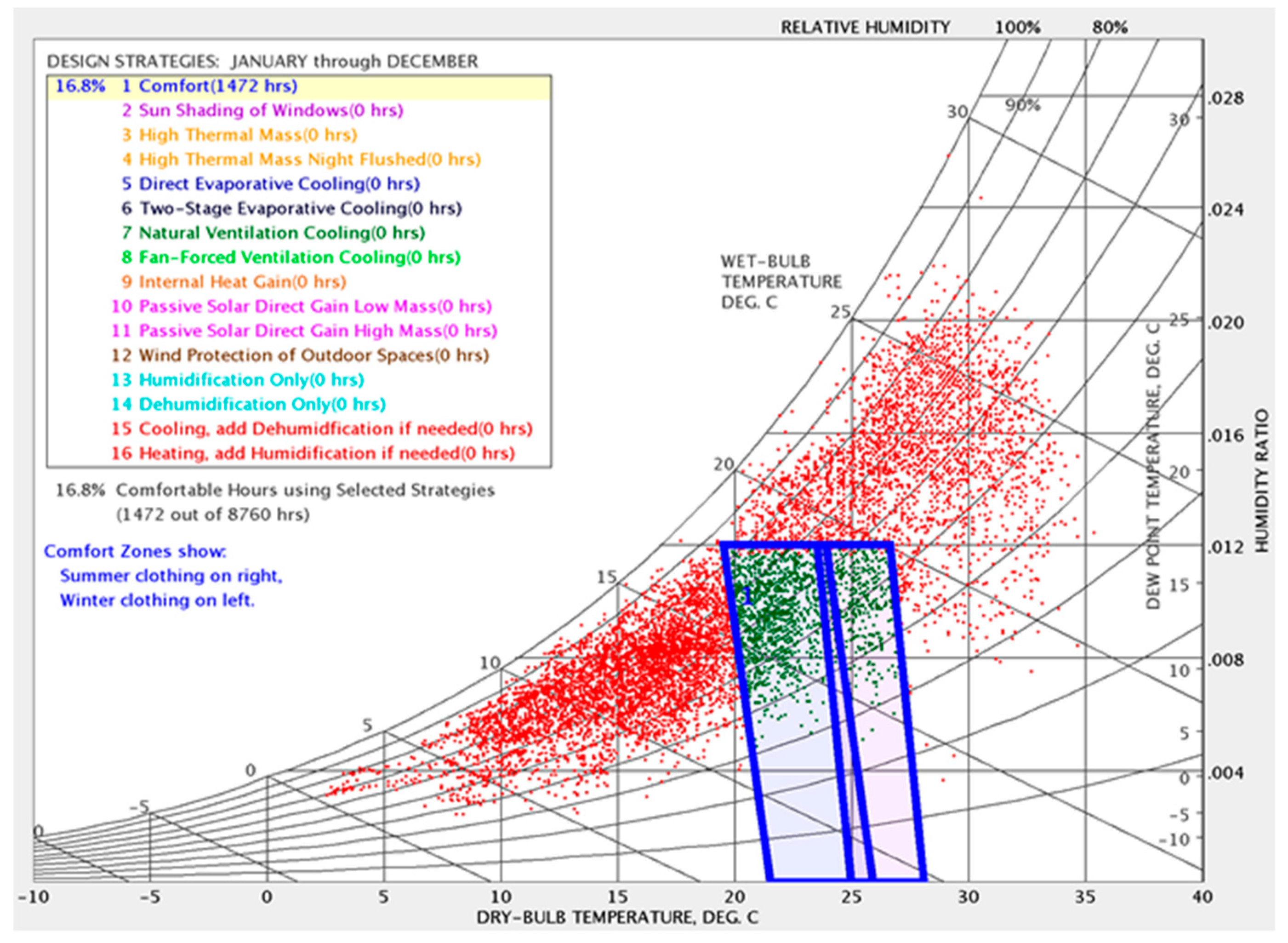
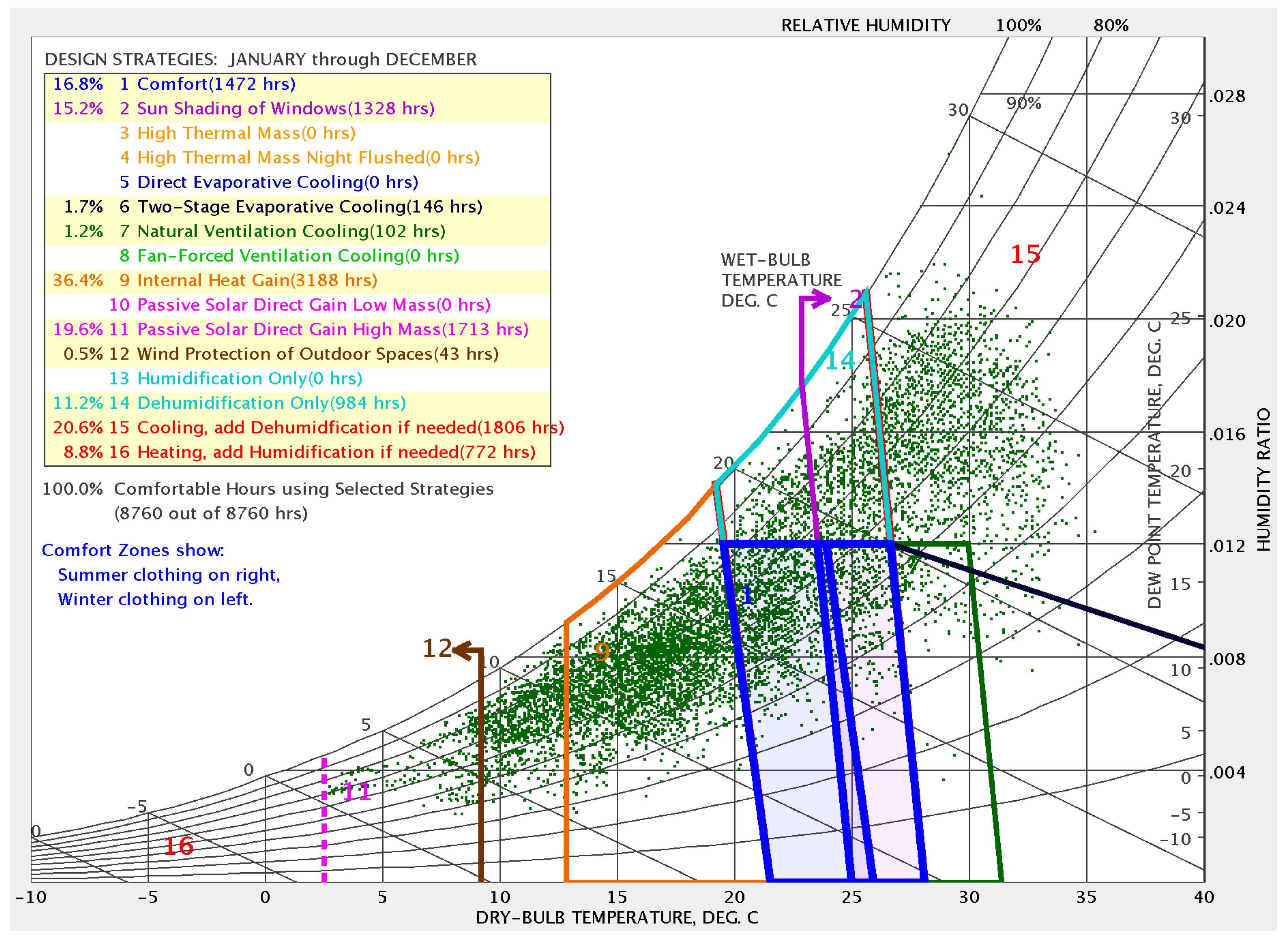
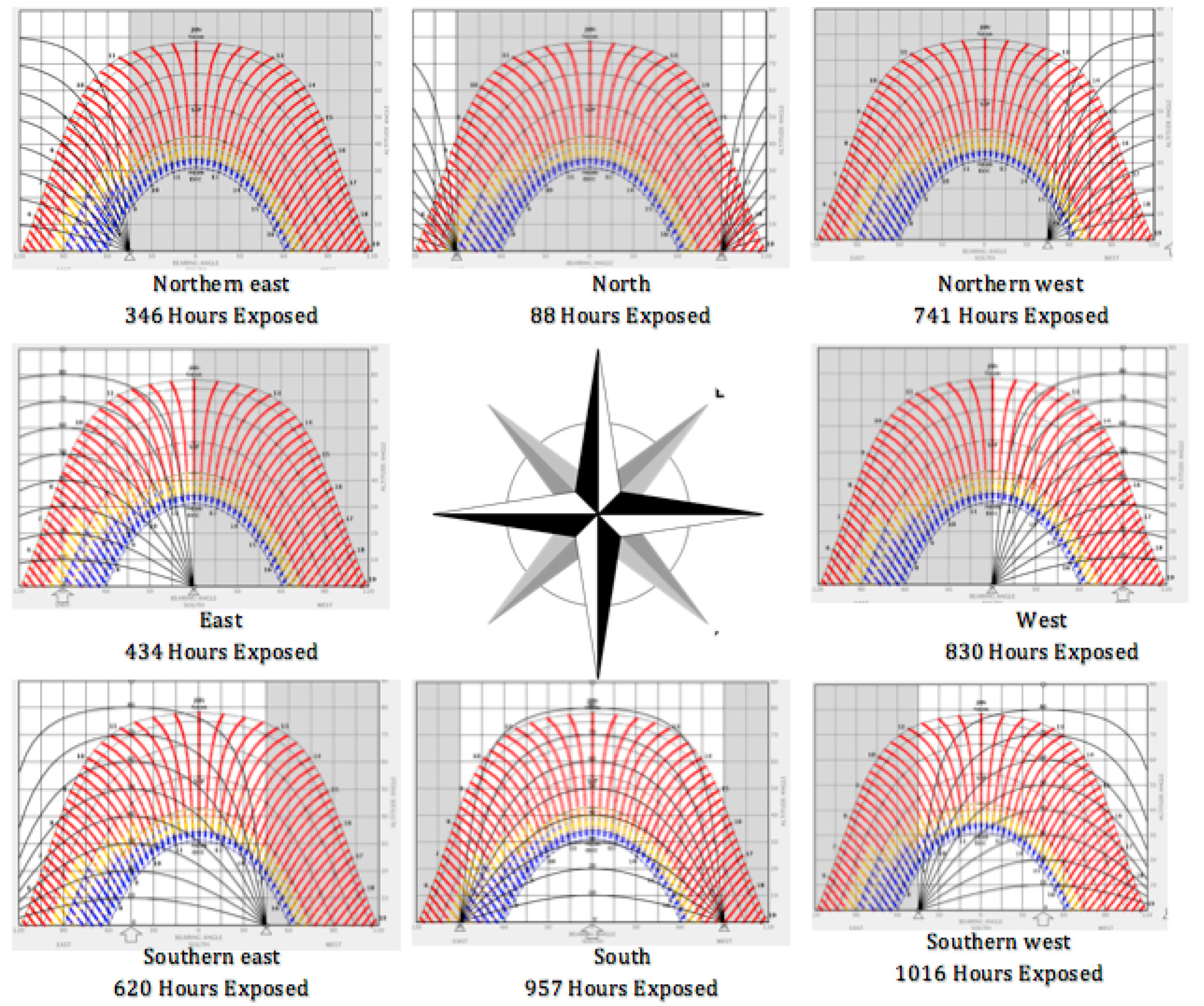
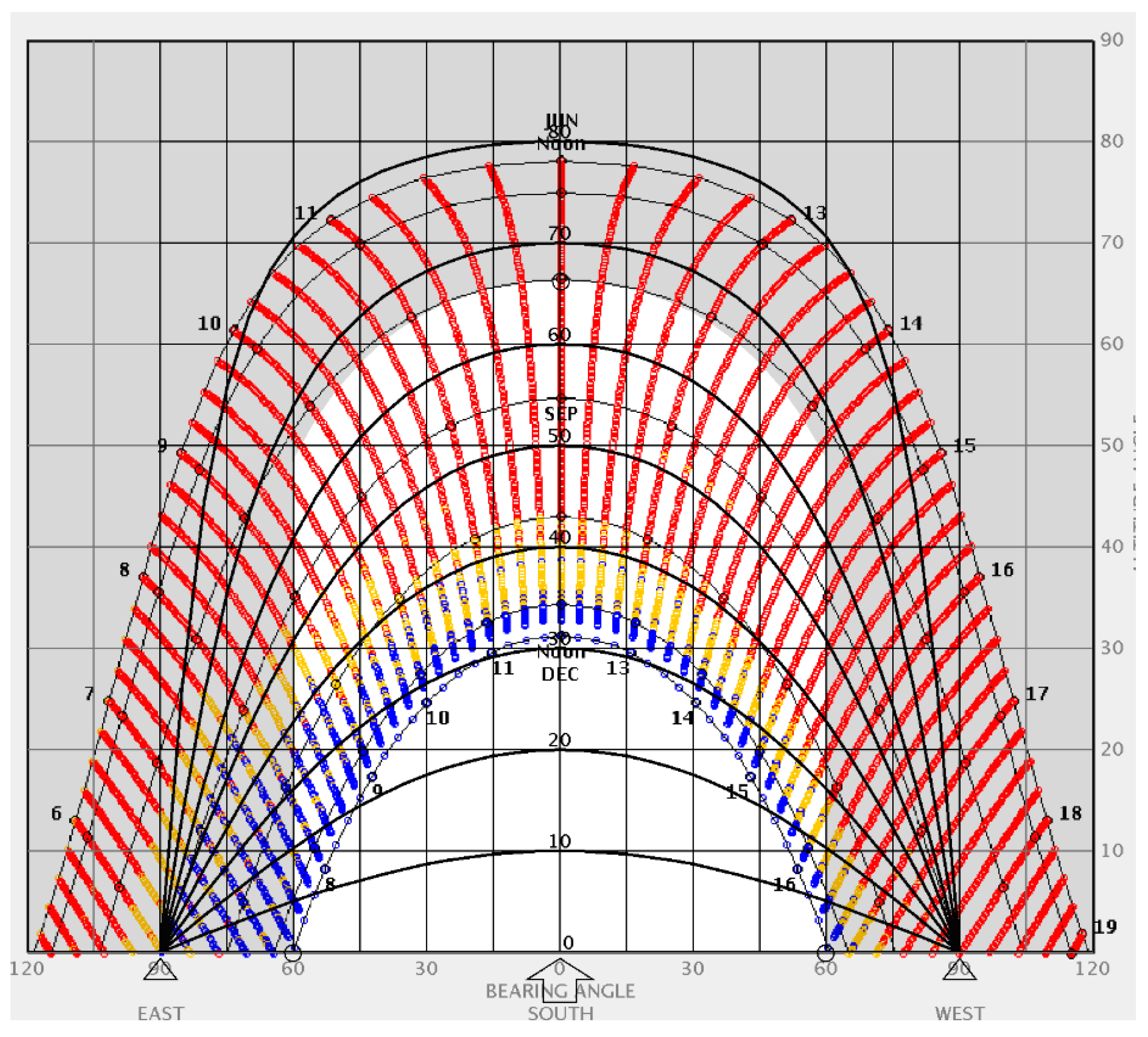
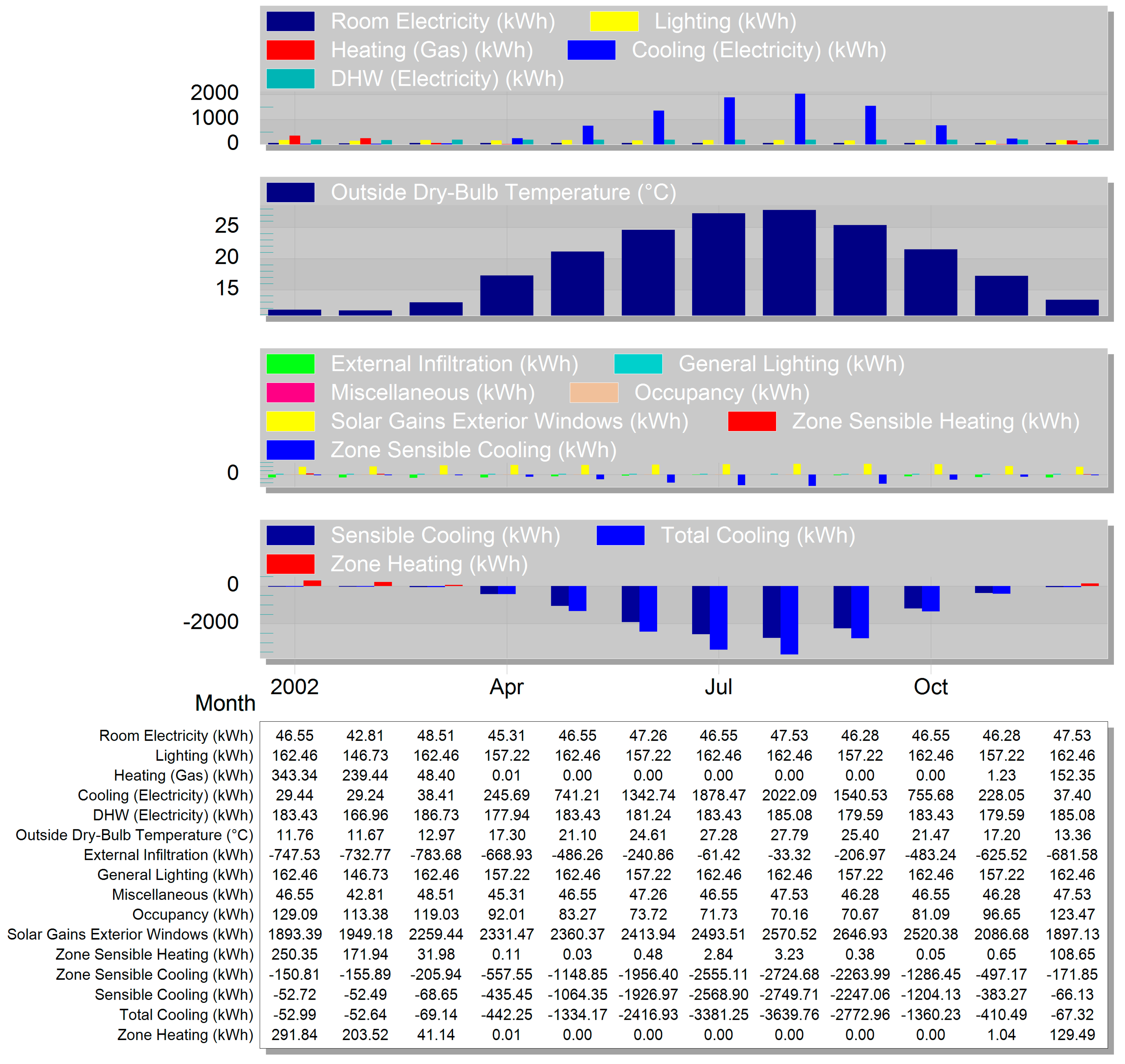
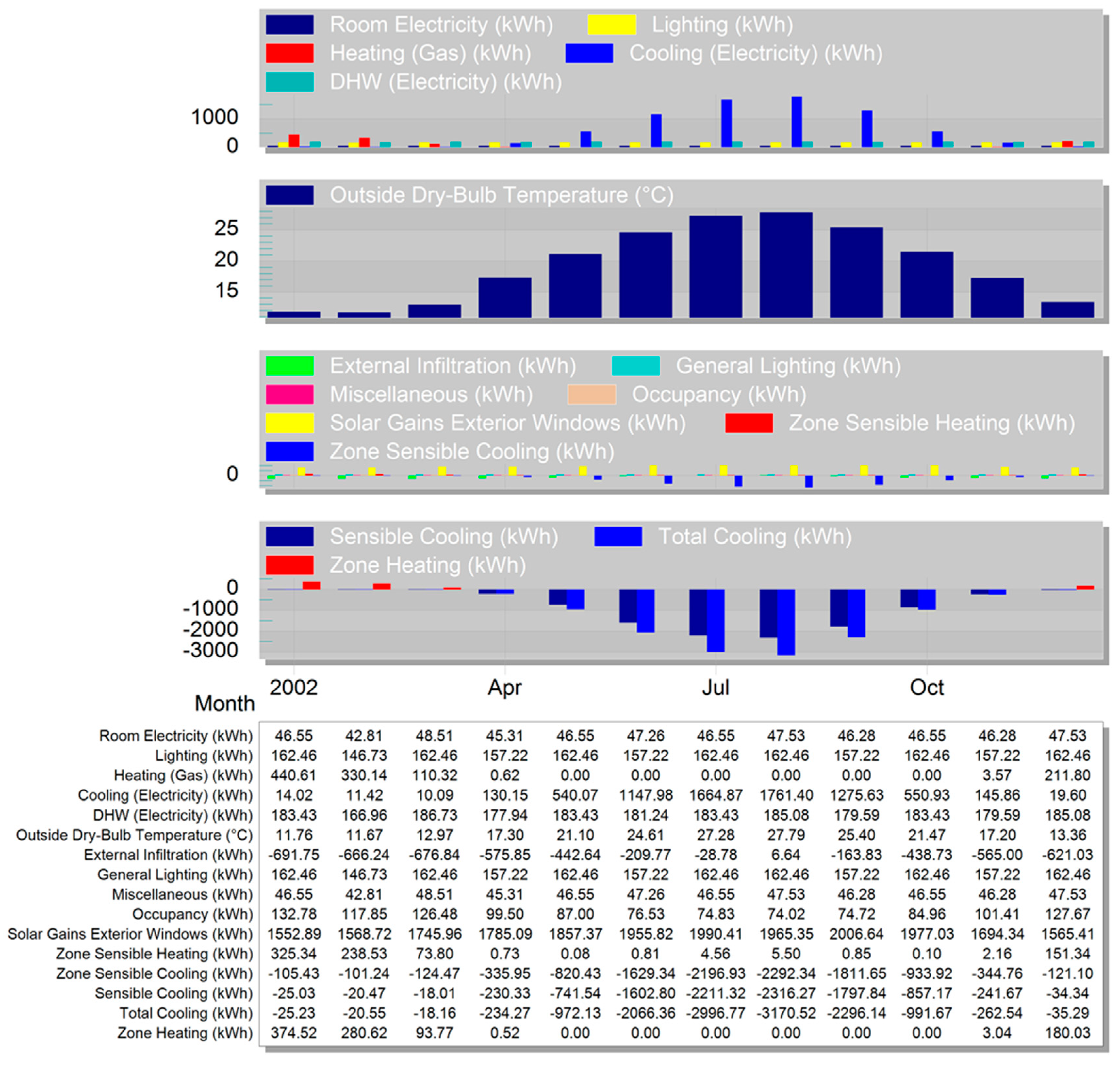

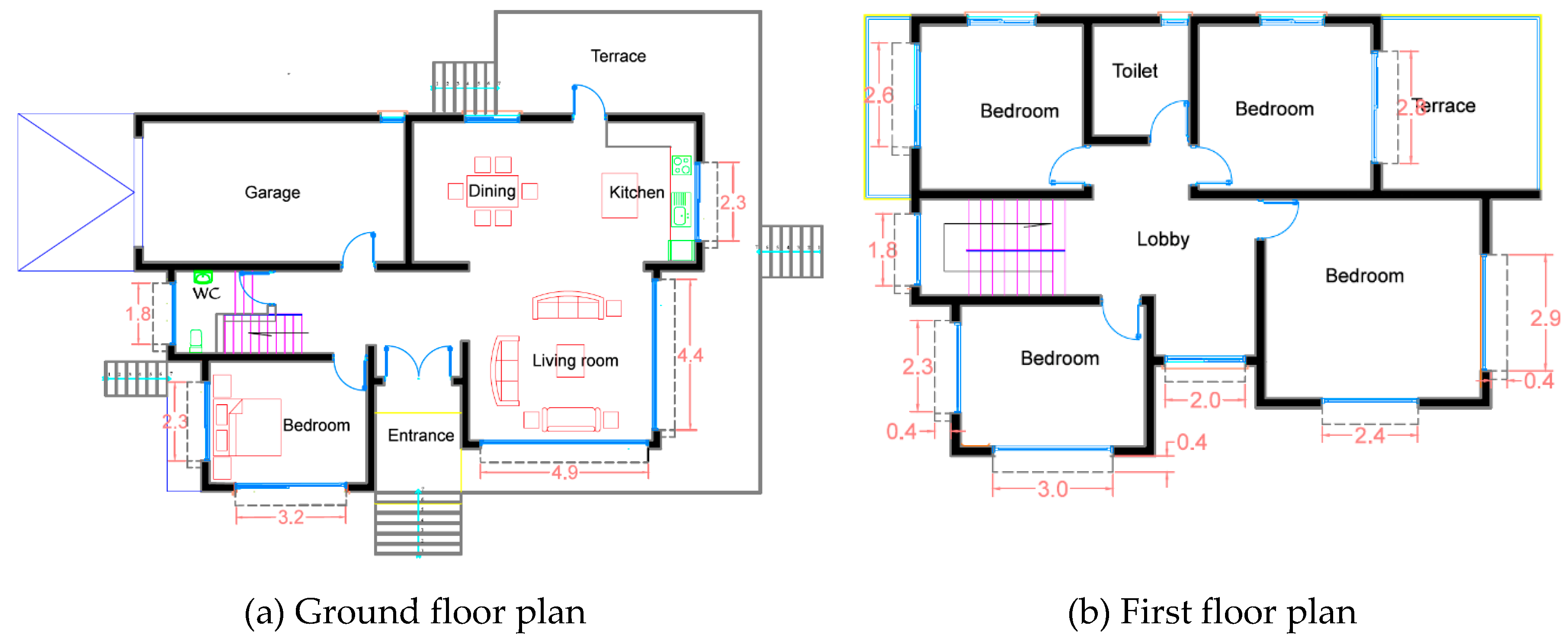
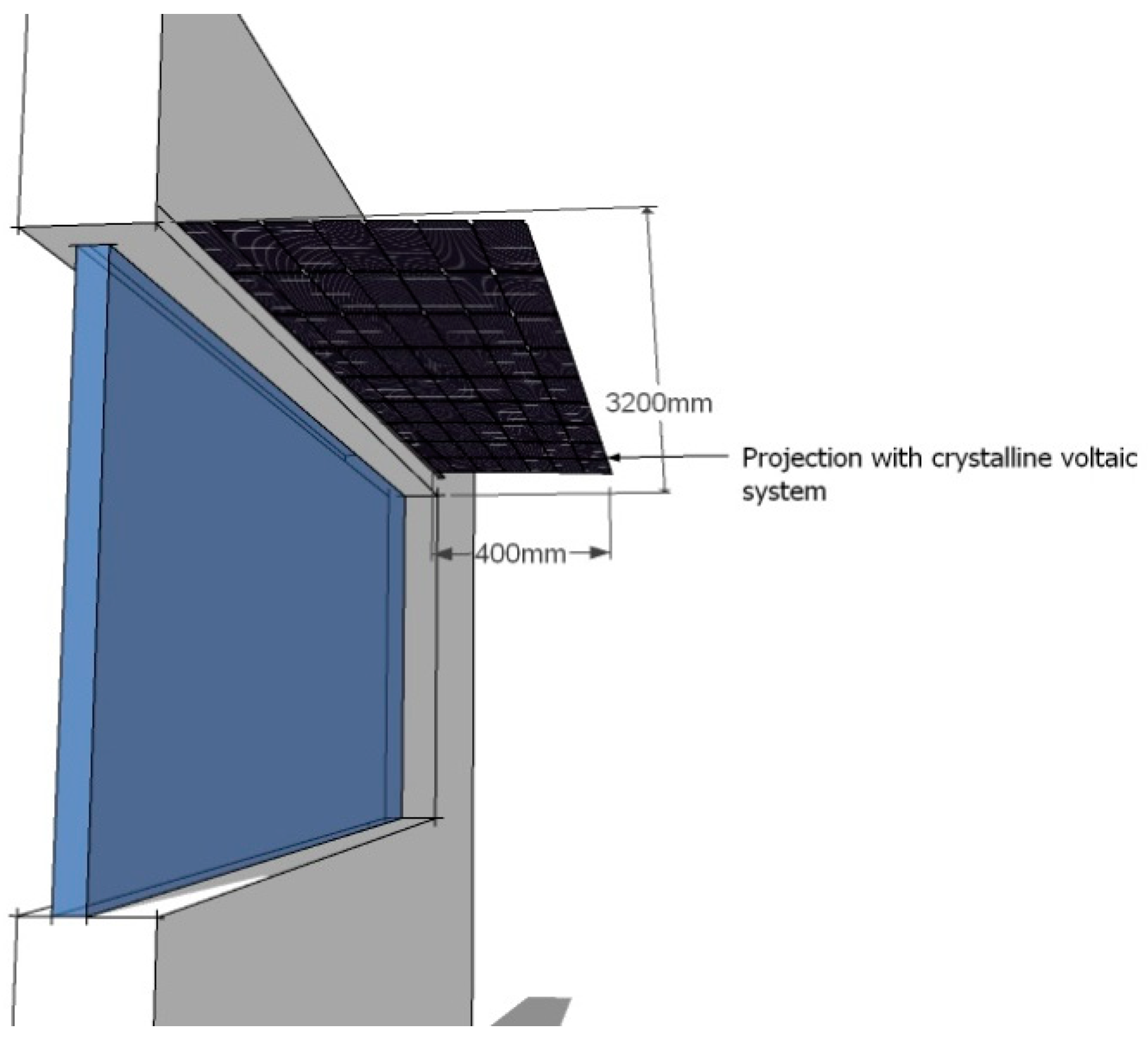
| Location | Type of Technology | Number and Sizeof Units | Fuel | Total Installed Capacity |
|---|---|---|---|---|
| Teknecik | Steam Turbine | 2 × 60 MW | Heavy fuel oil | 120 MW |
| Teknecik | Gas Turbine | 20 MW + 10 MW | Diesel | 30 MW |
| Teknecik | Diesel Generator | 8 × 17.5 MW | Diesel | 140 MW |
| Dikmen | Gas Turbine | 20 MW | Diesel | 20 MW |
| Kalecik | Diesel Generator | 8 × 17 MW | Diesel | 136 MW |
| Kalecik | Steam Turbine | 6 MW | Heavy fuel oil | 6 MW |
| Serhat | Solar | 1.2 MW | - | 1.2 MW |
| Total | 453.2 MW | |||
| Total without Gas Turbines | 403.2 MW |
| Sustainability Dimension | Benefits | References |
|---|---|---|
| Environmental aspects | Ability to produce clean energy by converting unwanted solar radiation into electrical energy. There is no side effect to the ecosystem. The cooling load is reduced when PVSDs are introduced. When PVs are used as shading device, they generate energy and serve as protection from glare, hence improving the visual comfort of the users of the space, enhancing specific architectural expression through the application of colored and semi-transparent PV products. | [31,32,33,34]. |
| Economical aspects | The energy is generated in situ and not centrally, there are savings in terms of the cost of distribution and greenfield. The cost of material is saved since the PV is serving as both an energy generator and as a building component. | [34,35] |
| s/n | Building Information | Description |
|---|---|---|
| 1 | Project | Residential building |
| 2 | Type | Single family detached house |
| 3 | Area of building | 149 m2 |
| 4 | Climatic region | Mediterranean climate |
| 5 | Orientation: | South |
| 6 | Number of floors | Two floors |
| 7 | Window material | PVC |
| 8 | Window configuration | Double glazing |
| 9 | Windows type | 3 mm clear glass + 6 mm air gap + 3 mm clear glass |
| 10 | Level above ground | 1 m |
| 11 | Orientation of the openings | South, east, west, and north |
| 12 | Outside shading device | Louver and cantilever |
| 13 | Door material | Wood |
| 14 | Wall type | Bearing and partition |
| 15 | HVAC system | Slit unit |
| Lighting | Illuminance (lux) | 150 |
|---|---|---|
| DHW | Consumption rate (l/m2-day) Delivery temperature (C) | 0.72 65 |
| Equipment | Unit consumption (W/m2) | 3 |
| City | U–Value (W/m2k) | |||
|---|---|---|---|---|
| Wall | Roof Ceiling | Floor | Windows | |
| Famagusta Northern Cyprus | 0.56 | 0.67 | 0.44 | 0.8 |
© 2019 by the authors. Licensee MDPI, Basel, Switzerland. This article is an open access article distributed under the terms and conditions of the Creative Commons Attribution (CC BY) license (http://creativecommons.org/licenses/by/4.0/).
Share and Cite
Ogbeba, J.E.; Hoskara, E. The Evaluation of Single-Family Detached Housing Units in terms of Integrated Photovoltaic Shading Devices: The Case of Northern Cyprus. Sustainability 2019, 11, 593. https://doi.org/10.3390/su11030593
Ogbeba JE, Hoskara E. The Evaluation of Single-Family Detached Housing Units in terms of Integrated Photovoltaic Shading Devices: The Case of Northern Cyprus. Sustainability. 2019; 11(3):593. https://doi.org/10.3390/su11030593
Chicago/Turabian StyleOgbeba, John Emmanuel, and Ercan Hoskara. 2019. "The Evaluation of Single-Family Detached Housing Units in terms of Integrated Photovoltaic Shading Devices: The Case of Northern Cyprus" Sustainability 11, no. 3: 593. https://doi.org/10.3390/su11030593
APA StyleOgbeba, J. E., & Hoskara, E. (2019). The Evaluation of Single-Family Detached Housing Units in terms of Integrated Photovoltaic Shading Devices: The Case of Northern Cyprus. Sustainability, 11(3), 593. https://doi.org/10.3390/su11030593





